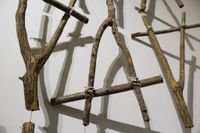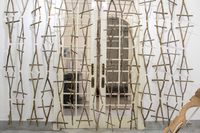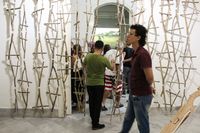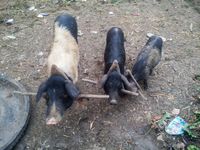CASCADA
CASCADE
Installation
2019
In collaboration with Disbel Roque Bolaño
5.30W x 3.00H Mtr
Wood, rope and string
Cascada, is a kind of curtain of forks, these objects are used in rural areas to prevent small livestock from escaping from the fenced areas that delimit their activity in "freedom". The installation is interactive in nature, imposing on the public a barrier to transgress. The work intervened a gallery door and drew a line from wall to wall to create a barrier. Tickling the public with the roughness of the wood, rubbing the skin of all attendees, interested us as an exercise imposed on the viewer of containment or transgression.
Immobility and statism are entrenched symptoms in small communities. The pitchfork in this case is shown to us as a coercion and associates its concept with a submission that must be insurmountable. Obedience, which from the Christian religion is related to a type of animal -the sheep- but which in the Cuban context is a symbol of a very particular obedience to the political and social issues of the country.
The peasant economy is related to a somewhat conservative idea based on the supposed ignorance of the society that surrounds it. To a certain extent, this naivety allows the dominant powers to operate more effectively with these groups of individuals.
Social power imposes a relationship that could be catalogued as a training of the masses. Just like the animal and its master, an indoctrination is implemented in which individuals adopt a series of behaviors, customs and ways of acting that at first glance seem completely natural. But the truth is that they are conditioned by processes of social interaction, which in turn are determined by the different human powers.
The way in which the social strata project themselves depends to a large extent on the domains to which they are subjected. The social forces close to the center of absolute power receive as much attention as those that are "isolated" or difficult to access physically. Herding reaches everyone, with individual attention, but it is nonetheless a technique of massification and registration.
The instruments of training and cultivation of agricultural areas in Cuba (and in some other underdeveloped countries) have an archaic technological visuality. Five hundred years of tradition and the mechanisms are still the same. The meekness they provoke makes us think of these objects as an image that is perpetuated not only for the animals, but also for the human mass that populates the whole country.
The elements of domination of the Cuban countryside remain to this day very similar to those used a couple of hundred years ago to subdue "races". It may be that in a humane way they do not directly subdue the other with evident physical violence. But symbolic violence is permeating the relationships of individuals with their social systems, and more so when these struggles are subject to the idea that work should be under a unifying element and equal possibilities for all.



